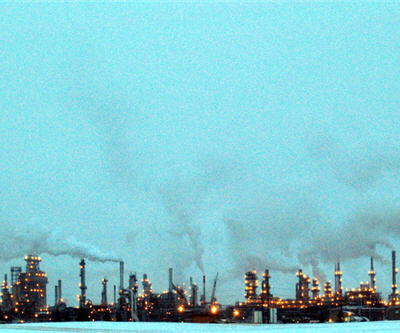
The price oil sands producers receive fell to crushing $49.80 a barrel below the international benchmark after a widening to $33 of the spread between the price of Western Canada Select – a blend of heavy oil sands crude and conventional oil – and US crude on Tuesday.
Canadian heavy oil is lagging US benchmark West Texas Intermediate (WTI) which is up 12% since November while the discount to the global oil price in the form of North Sea Brent has narrowed to $16.80.
Brent settled at $114.10 in Europe which translates to an effective price for bitumen-derived oil from Alberta’s oil sands of only $64 a barrel.
Patricia Mohr, commodity guru at Canada’s Scotiabank predicts more pain for Alberta’s oil sands players saying the WCS discount should climb to nearly $37 in February.
Commenting on the bank’s latest commodity price index out today, Mohr says there are three primary reasons Canadian crude is falling behind and that the cost to the Canadian economy is ‘enormous’:
Aside from March and April 2012, the discount on WCS has only once before — in October 2007 — been above the US$30 mark, since this crude-blend was first introduced in 2005.
While a discount off light oil is normal, given more complex refining required for heavier crudes, the discount averaged less than US$18 from 2005-11 and was as low as US$9.56 in 2009. (The double-discount on WCS, including the discount on WTI relative to Brent — a ‘world’ price — totalled just over US$50 per barrel on January 25.)
A wider-than-normal discount also emerged last year on some grades of Alberta ‘light’ crude oil (the Edmonton par price averaged US$8.48 per barrel less than WTI in 2012 and was US$13.13 lower in December — compared with a discount of only US$2.64 from 2005-11 — likely reflecting the increasing availability of light oil from the North Dakota Bakken and Eagle Ford shale in the U.S.). Upgraded light synthetic crude oils — produced by Syncrude Canada and Suncor — sell at a slight premium to WTI [$1 on Tuesday].
In the case of WCS heavy oil, the enormous price discount largely reflects three developments: 1) inadequate pipeline capacity to handle growing exports of blended bitumen from the Alberta oil sands as well as ‘light, tight’ oil from the Saskatchewan Bakken, exacerbated by the remarkable growth in supplies of ‘light, tight’ oil from the North Dakota Bakken and Rocky Mountains, competing for limited pipeline space with Canadian oil; 2) an over-reliance on one key export market — the U.S., especially the Midwest —’commercially risky’ for any industry, rather than developing markets in the faster-growing Asia/Pacific region — resulting in a buyers’ market; the delay in U.S. approval of the northern leg of the Keystone XL pipeline has raised further concern over pipeline capability and suggests the need for export diversification; and 3) an earlier-than-normal pattern of seasonal downtime at U.S. Midwest refineries in early 2012 and a delay in the BP Whiting, Indiana refinery upgrade (a new coker and de-sulphurization unit) to handle increased flows of Alberta heavy oil.
The pipeline system from Canada to the United States now has little ‘operating flexibility’ to handle disruptions (caused by reduced pipeline pressure or technical problems on other pipelines, backing up flows onto the system). Some redundancy in pipeline capacity is required.
The ‘opportunity cost’ of these discounts is enormous for the Alberta and Saskatchewan economies as well as for Canada — reducing government royalties/income tax receipts and ultimately governments’ ability to fund ‘social services’ and ‘public infrastructure’.
Canadian oil producers — as well as many in the U.S. — are turning to rail to reach higher-value markets on ‘tide-water’ or in the U.S. Northeast and to ‘bridge’ the gap ahead of pipeline development. More than six companies operating in Western Canada are using rail (Baytex Energy, MEG, Crescent Point Energy, Surge Energy, Southern Pacific Resources (STP) and Twin Butte Energy), transporting as much as 300,000 barrels per day (b/d) of crude oil. Rather than accept wide WCS discounts, Baytex Energy (a heavy oil producer) trucks some of its crude to a rail terminal, with a third-party mid-stream marketer railing the crude to higher-value markets (possibly as far south as the U.S.Gulf, where international prices prevail).
The higher cost of rail versus pipeline transport is more than offset by prices closer to international levels. Interestingly, the price of Maya heavy oil in Mexico and sold in the US Gulf (a crude of similar quality to WCS) is actually priced above WTI oil — e.g. at US$101 (FOB Mexico) on January 11, 2013 compared with US$61 for WCS in Alberta and WTI oil at US$94). In its third-quarter financial results, Baytex Energy expected that 35-40% of its heavy oil volumes would be railed by year-end 2012. (Shipment by rail also does not require the use of costly diluents to flow heavy oil through pipelines.)
Despite challenges in moving crude oil to market, a major heavy oil project will come on stream in Alberta in the next several months — Imperial Oil/ExxonMobil Canada’s Kearl Lake (110,000 b/d in 2013 — to be expanded to 145,000 b/d within three years, 290,000 b/d by 2017-18 and 345,000 b/d by 2020). Some of this crude is likely bound for the U.S. market. We note that Exxon/Mobil has its own pipeline from the U.S. Midwest to the US Gulf.